Legend of the Five Rings: B-1 Code of Bushido by EverettLO
Post
Original SA post B-1 Code of Bushido , a First Edition Legend of the Five Rings Adventure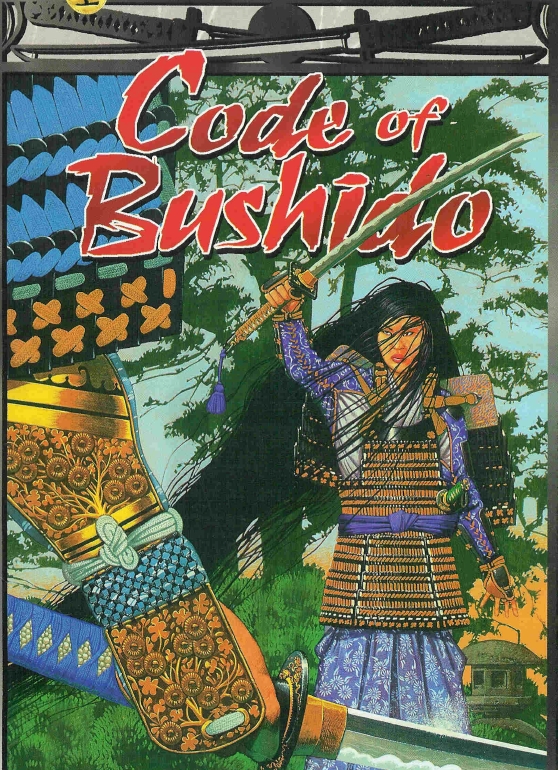
I’ve mentioned this adventure a couple of times in various threads and I figure it’s about time to run an F&F review. I should also mention, I’ve been mistakenly referring to it as Honor’s Veil , which was actually a separate, earlier adventure. Code of Bushido was one of the earlier releases for the first edition of L5R and came out in 1998. It is the first adventure in the Bushido series (B-1). At this time they tried to divide up the adventures by theme and labeled them in the same way that old TSR D&D adventures were labeled. Alderac really seemed to like aping early D&D, and included several boxed sets and an adventure that is an explicit nod to The Tomb of Horrors . It’s not really important, but I’ve always found it strange.
The book starts with an introduction of what to expect. It’s composed of three linked adventures that are intended to make the players wrestle with the sometimes problematic outcomes that following the Code of Bushido will lead to. It’s a strange conflict to me – you’re basically counting on your players to act on their modern sense of right and wrong and watch it conflict with Rokugani norms. On the other hand, these things wouldn’t be a big problem for the character who have grown up in the culture. It was written by several different people, but the two biggest names to remember are Ree Soesbee and John Wick. Ree Soesbee was famous mostly for making the Crane Clan synonymous with her own vision of them as pacifistic artisans. John Wick probably needs no introduction.
There is also a note in the credits that the original draft was by Greg Stolze, but he is not listed as a main writer. I’m not sure what that means other than his version was basically entirely done away with. That seems to have happened with a lot of his work on early L5R stuff. His main, untouched contribution to the system was in the City of Lies boxed set. It’s a great addition to L5R and still sees a lot of use today.
I’m hoping everyone is at least moderately familiar with L5R. It’s a high-ish fantasy version of Tokugawa era Japan with a smattering of other cultures thrown in. You play as samurai working for one of the seven (at this time) great clans. There is an incredibly deep history to the world and a metaplot so strong that it turns a lot of people off on the game. I chose to review this adventure in particular because it captures a lot of the feel of early L5R adventures: lots of railroading, weird assumptions of character behavior, and danger from the designers not understanding their own system.
The first adventure in the module is called A Matter of Honor . There’s an annual celebration in Phoenix lands at the Shrine of the Ki-Rin known as the Setsuban Festival. The biggest portion of this festival is the Grand Tournament, which shugenja (basically Shinto priests who can cast spells by getting help from spirits) from all over the empire come to test their skills. It’s basically a spellcaster duel, later called taryu-jiai, and didn’t get official rules until 4th edition around 15 years later.
Like most tournaments in Rokugan the Setsuban Festival attracts important nobles and involves politicking like nobody’s business. The most notable guest at this festival is a young lady named Otomo Yoroshiku, the Emperor’s niece and perhaps the most eligible woman in the Empire. A couple of the PCs (it is assumed that there are at least two male characters) have been ordered by their daimyo to seek her hand in marriage. A marriage into the Emperor’s family would be a huge boon to any clan in the empire and every clan seeks to reap the political windfall.
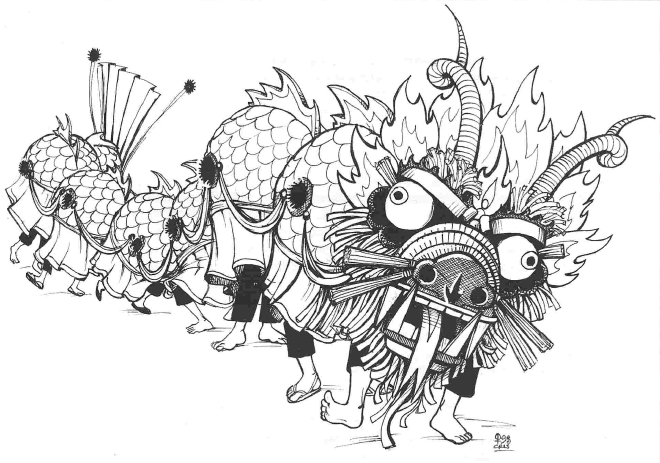
The other, likely less politically connected characters are forced to act as guards to a caravan of scrolls. The prize for winning the Grand Tournament is a cache of rare and valuable scrolls, one volunteered from each of the major shugenja schools of the great clans. The last leg of the caravan’s journey is under the protection of a Unicorn Clan lord known as Shinjo Gidayu. The characters are coerced into helping guard the cache through various means. If the characters bother to ask Gidayu why he doesn’t have his own people, notably his karo (seneschal) look after it, he’ll tell them “I do not have a karo. My karo is dead.” in what I assume are ominous tones.
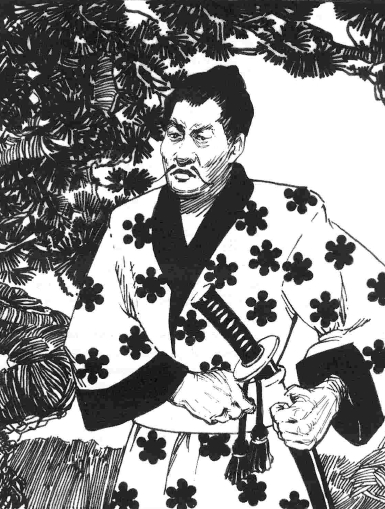
There are a few small vignettes along the path from Shiro Iuchi to the festival. The caravan passes Drowned Merchant River, where the characters have a chance to see some scary ghosts and perhaps help lay them to rest. They also pass through the lands of Clan Dragonfly where they get a chance to mitigate a political scandal when a Dragonfly shugenja who was not invited to the tournament attempts to copy the scrolls. All of these pieces feel like they’re just thrown in to pad out play time. Finally, when nearing the festival, the caravan is hit by bandits.
The bandits attacked when the caravan was between two steep hills and strung out in single file. Archers rain arrows from atop the hills, but anyone passing a perception check will notice that they aren’t trying to kill anyone. They just seem to want to keep the guards pinned down. Meanwhile, a ronin shugenja named Koan (first edition was really bad with names) uses spells to put the guards and PCs to sleep. To hit the TN 30 Earth roll and stay awake, on average, requires an Earth of 6, which is literally impossible at this point in first edition. It’s just another way of saying ‘your PCs went to sleep’.
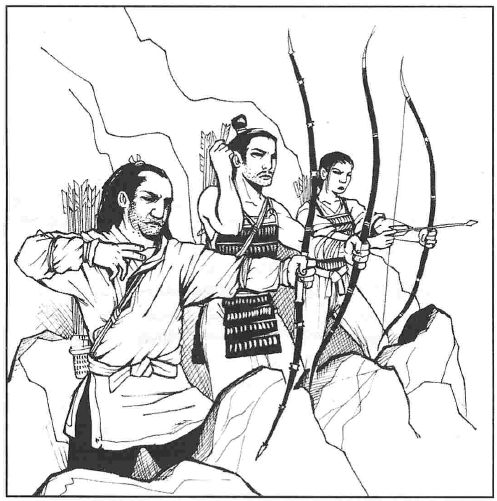
An NPC shugenja who was also guarding the scrolls manages to stay awake long enough to get into a battle with Koan, accidentally set the caravan on fire, and get killed. Koan makes off with the scrolls. This whole scene is railroady as hell and, in a great example of bad GMing, turns the PCs into bystanders in their own adventure.
If the PCs awake and decide to follow the bandits, they find that their prey crossed a steep ravine and cut the only bridge. It’s assumed that your players give up at this point and go on to report their failure. I don’t even know how to explain how dumb this is. No players I know are going to let a topographical feature stop them from regaining the one thing they were charged with guarding. That’s the adventure! Getting the scrolls back from dozens of armed bandits sounds like a pretty normal setup.
For two, it doesn’t make sense in-universe. Your samurai are honor bound to protect the scrolls and aren’t going to want to report their failure when there’s still a decent chance they can get them back. I mean, this is going to cause a serious problem for the festival and people have been forced to commit seppuku for a hell of a lot less. Getting killed trying to retrieve the scrolls is the better option.
Third, it doesn’t even make sense from the standpoint of the stated theme of the adventure. The theme is to show how the code of Bushido can lead to problematic outcomes. Charging after a host of bandits into likely death sounds like one of those outcomes, not slinking away to report failure.
However it happens, your PCs have to leave for the festival empty handed and with at least one corpse. When they reach the festival they may notice a couple of other things. For one, everyone is already deep in trying to win the hand of Otomo Yoroshiku. For two things, there are absolutely no ronin running around – the Phoenix Clan has specifically outlawed them from tainting the festivities. For three, the PCs are being followed by a child who always manages to stay just out of reach.
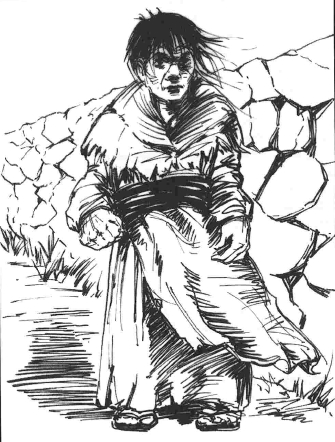
This is, ostensibly, a child.
Eventually they have to report their failure to Gidayu, and he is calmer than might be imagined. He is very upset about the death of his favorite shugenja and upset at the potential dishonor accorded to him for losing the scrolls ostensibly under his care. He makes veiled threats that the consequences will fall to the PCs as well and more or less orders them to go back and find the scrolls. To ensure that things go smoothly, he sends one of his samurai, a woman named Shinjo Iruko, along. She’s the woman on the cover shot. I have literally no idea why they needed this entire scene and could have chased the scrolls from the start. I guess the writers really felt that they needed Iruko around to help coerce the players in what comes next.
Thanks to nothing more than GM fiat the PCs can now follow the trail the bandits left behind. It leads to a picturesque village in the mountains called Village of the Nightingale. The village appears to have been founded recently by ronin looking for a place to call home. A grizzled looking ronin named Niban and his lieutenant, a ronin woman named Tobuko, greet the characters in the center of town. Of course this means the PCs are now surrounded by dozens of potentially hostile ronin. It turns out the scrolls were stolen to provide the ronin with leverage to get Koan into the tournament; they will not return the scrolls unless the Phoenix allow Koan to compete. Iruko pushes to just accept a deal and try to negotiate the Phoenix into allowing a ronin into the competition. It’s probably the only option that’s not going to result in the death of the PCs, so it seems reasonable to assume it happens. It should note: combat in the L5R system is ridiculously deadly. Possibly the most important skill for a combatant is being quick on the draw. A single sword stroke will likely kill or cripple a character and there is one hell of a death spiral cooked into the combat system. Any combat is foolish, and this combat in particular would be suicidal.
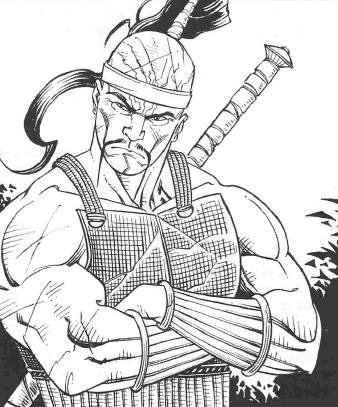
The PCs now have the challenge of convincing the hidebound Phoenix clan officials to violate their own dictates. It is certainly an interesting challenge. It shouldn’t be too much trouble, though, since they will have the backing of Gidayu and the ronin currently hold most of the cards. They crack, decided to allow Koan to compete, and the scrolls are summarily returned.
If any of the PCs are shugenja, they are allowed to compete in the tournament. Canonically, though, it ends with Koan making it to the final four and intentionally throwing his match against a Crane clan shugenja in an effort to stay diplomatic. The Phoenix accepted the idea of a ronin competing, but were never going to allow a ronin to win. The PCs are given appropriate honors for guarding the scrolls (or given grudging respect for negotiating out of a hard spot) and now have a powerful ally in Shinjo Gidayu. He offers to let Shinjo Iruko act as one of their bodyguards, mainly so he can have eyes and ears on them in the future.
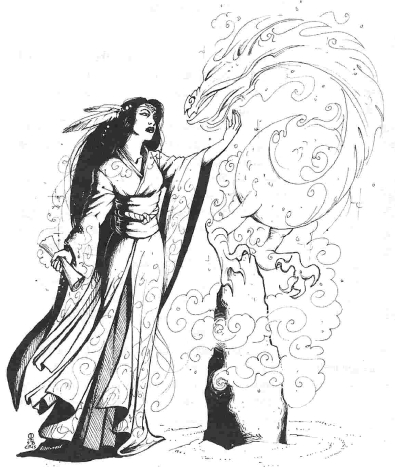
That’s the end of the adventure. The ronin made their mark and negotiated with a great clan on their own terms. The tournament went off without another hitch. The only thing that bothers me is that every bit of this thing was pre-scripted and there is no room for the players to be clever. It’s just one long railroad from start to finish. Unfortunately, that’s a common thing in the early adventures. On the plus side, it doesn't contain much evidence of John Wick's early habit of putting women at a disadvantage in Rokugani society. For some reason he equated Rokugan with 1600s era Japan and left in the patriarchal parts.
Next time: Testimony, Murder, and Lies .
Post
Original SA post B-1 Code of Bushido Part 2
We now moving into the second adventure of Code of Bushido, called Testimony, Murder, and Lies . At its heart we’re dealing with a murder mystery with a lot of frivolous extras. Many, if not most, of the early L5R adventures had the PCs acting as police (magistrates). It makes it a hell of a lot easier to understand why your characters are involved in an investigation at all. Most of my games of L5R end up with the same setup: the PCs end up as Emerald Magistrates after a good showing at the Topaz Championship. It saves a lot of time and many of the implausible reasons for your PCs to be involved can be avoided.
The PCs are invited to Winter Court held in Kyuden Asako due to their involvement in the proceedings of the last adventure. Winter Court is the way that many of the more courtly samurai spend their winters prior to the campaigning seasons of spring and summer. Lots of gossip, jockeying for position – basically a social battlefield. This particular Winter Court is again centered on Otomo Yoroshiku and her suitors. The adventure introduces a wealth of characters to round out the suspects. The most important one is the young daimyo of one of your PCs families. He’s brash and kind of stupid and wants the characters to help him win her hand. Others include Mirumoto Hanzu, a competent duelist, Yoroshiku’s three handmaidens, Shiba Himitsu who seems bitter toward the princess, and our ronin friend Koan from the last adventure. It also includes my favorite character, an old magistrate named Hiruma Usigo who is attending one last Winter Court before retiring and entering the monastery. An old cop just three
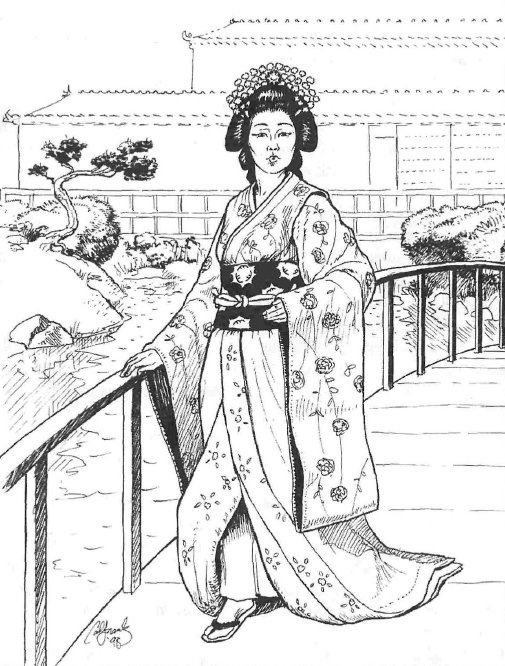
Court gets underway with a gift exchanging game that’s slightly more complex than I would ever use in a game. Really it’s just an excuse for your players to get to know the principal suspects and make the coming murder more shocking. The players get to witness the suitors attempts to outplay one another. They also get to watch as the samurai-ko who was assigned to be their bodyguard during the last adventure, Shinjo Iruko, makes fumbling attempts to catch the attention of one of the PCs she has a crush on. The players get to watch a wonderful play by a troupe of Scorpion Clan actors who are attending court as the entertainment.
Eventually Yoroshiku gets cornered by one of her suitors and this leads to a poetry competition. Before any of her suitors have a chance to deploy their skills at verse a drunken Shiba Himitsu drops a haiku that calls her a weed within the Imperial family’s garden. It pretty much kills the celebration and the PC’s daimyo demands to know what it was supposed to mean. Himitsu sneers and tells him that he will see tomorrow night. The daimyo instead decides to challenge him to a duel to the death for insulting Yoroshiku’s honor. It is quickly confirmed and scheduled for dawn the next day.
Now we enter the investigation phase, and the authors show that they don’t have a clear idea how their own system works. Tons of surprisingly high difficulty tests are thrown around to notice clues important to the case and for things that happen in later adventures. We begin with a TN 20 awareness check to see if the players notice that Koan is shifting uncomfortably during the whole previous scene. That is not an impossible TN by any means, but a player still needs an Awareness stat of 4 to have better than even odds of hitting it. For those who don’t know, the stats in L5R 1e went from 1 (totally inept) to 5 (incredible). There were no rules in first edition for going past 5, but plenty of NPCs were statted that way and it was an easy thing to work out. The point is, unless a character is specifically made for something involving that stat, most stats won’t get above 3 until the PCs are extremely experienced. At least that’s how it’s gone in my games.
There is also an Awareness check at TN 30 to see if the PCs notice that one of the Scorpion actors is missing. If you have the maximum possible Awareness of 5, you still have a slightly less than 50% chance of hitting it. Anyone with and Awareness of 3 or less (which is probably most PCs) might as well not even bother. It’s possibly to drop Void points on these rolls to increase the odds of hitting the TN. I see most players only use Void in critical moments, though, such as combat or during a competition of some sort. Additionally, it is entirely likely that the authors meant for one of the PCs out of your four to six to hit it. That increases the odds, but does not make even obvious things a guarantee.
Everyone retires to their room for the night and the PCs daimyo calls them to his room to discuss Yoroshiku. He’s concerned about what Himitsu might have to say about her lineage and is worried that he is wasting his time wooing her. He’s a real romantic. Eventually the PCs head toward bed probably anticipating an interesting duel in the morning. Instead they are awoken just before dawn to an alarm. Someone broke into Himitsu’s room and killed him.
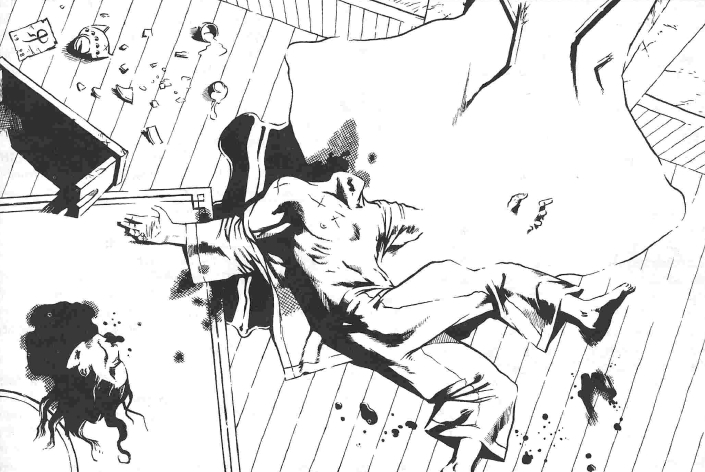
If the PCs are magistrates, they get to go look at the body. If not, their friendship with the old magistrate Usigo gets them in. There was clearly a struggle in the room as much of the furniture is knocked over and Himitsu’s body has several wounds other than the one that took his head clean off. It is also clear that he never reached his weapon, which was sitting near the door. The door itself was bashed in by someone very strong and the patio leading toward the courtyard was torn off its hinges during the suspect’s flight. This seems like a gimme, but the game recommends an awareness check of 15 for it, meaning an average person would likely not be able to put this together from a door bashed in on the floor.
If the PCs can pass a Perception/Investigation roll of 25 they notice a hidden board with a letter implying that Himitsu was going to meet with someone who had information about Yoroshiku’s lineage. The Perception/Investigation roll is within the realm of reason for someone built for it. I’d say an average beginner level Kitsuki Magistrate has about a 50/50 shot of it. An experienced one might even pull it off reliably. Hope you have one in your party!
Now the players begin to interview several witnesses. An old lady staying in the room next door heard a scuffle around 2 in the morning and looked through a crack in the wall. At first she saw a young lady struggling with Himitsu, but they moved out of her narrow view of the room and when she could see them again it was clearly the PC’s daimyo struggling with Himitsu. She freaked out and hid after seeing it.
The guards will tell you that earlier in the night the daimyo came to Himitsu’s room and got into a drunken shouting match before Himitsu calmed him down and sent him on his way without any violence. Some guards saw the daimyo walking back in the direction of Himitsu’s room around 2 AM. A guard outside also saw someone flee from Himitsu’s room out through the balcony and take a leap to the ground, but when she got across the courtyard the suspect was gone.
If the PC’s question Koan, he knows nothing but he is aware that his lieutenant, the ronin Niban, was working with Himitsu regarding the parentage of Yoroshiku. He doesn’t know what they were going to say, but he does know that Niban really seems to hate Yoroshiku.
Things look pretty bleak for the daimyo. He protests his innocence, but the weight of evidence, the testimony of witnesses, and the motive seem to point to his being the killer. Rokugan doesn’t have a formal trial process, so once the evidence seems to be fully collected, the local ranking noble gets to make a judgement. Likely that will be within another day or so.
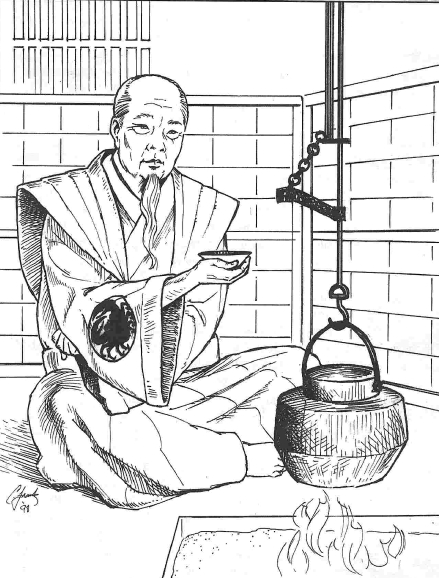
The old magistrate invites the PCs to have tea and discuss the case. He has also received an anonymous, cryptic poem that implies that he or the PCs should look into the whereabouts of one of Yoroshiku’s handmaidens. Tea is served by the magistrate’s servant and while the PCs are relating all the facts they’ve discovered, the magistrate slows down and falls over dead. He’s been poisoned and now his servant is nowhere to be found. Of course the PCs only notice the poison with an Awareness/Poison roll of 25 which is insane because why to the PCs know the poison skill? Again, perhaps they have an experience Kitsuki Magistrate on hand. A quick search of the premises find the body of the actual servant stuffed in an old fireplace. He was clearly killed hours before and whoever served the tea was a good enough mimic to trick an experienced magistrate who knew the original person personally. The only people who might possibly have skills like that are the Scorpion actors who are skilled enough at makeup and acting to potentially pull it off.
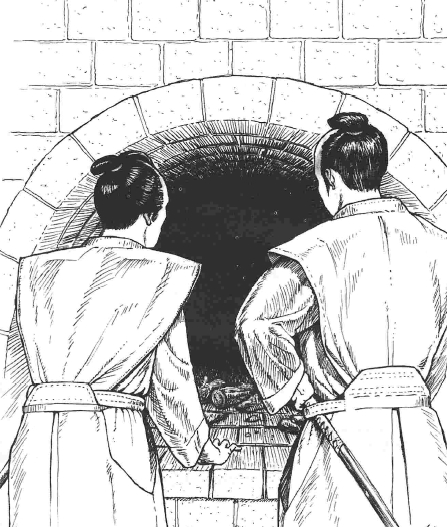
The actors are led by a woman named Shosuro Tage. She is not surprised to be considered a suspect but is able to provide an alibi for herself and all her actors at the times of both murders. Tage basically tells the PCs that the killer was one of Yoroshiku’s maidservants and that she is hiding in an old pantry beneath the kitchen. All of your investigative work before this interview are now utterly pointless. Up until now there was a real sense that if they didn’t piece together the right answer from a bunch of disparate clues then the wrong man would go to his death. Or maybe even the PCs thought that the daimyo is guilty. It could have gone a lot of ways, but now it’s laid out in a nice, obvious and linear progression. I also have no idea how Tage knows where the killer is hiding but I just chalk it up to ‘Scorpion circa first edition’.
When the PCs go to where they’ve been directed they find the killer. It starts out looking like Kakita Nantoko, who was Yoroshiku’s handmaiden, except she’s got several wounds with clotted, pitch black blood. She/it quickly changes shape into one of the PCs and attacks with inhuman speed and strength. Its entire right side is covered in a strange black tattoo or brand that seems to suck in all the light around it. The shapeshifter is incredibly dangerous based on the stats the game provides. It’s not terribly likely to hit a PC, but if it does then it will likely cripple or kill them simply due to its incredible strength. It is assumed that the PCs kill it and when they do it shifts back into the image of the young handmaiden, only with a large brand still visible along her side.
The Phoenix officials who own the castle are pretty interested in the obvious black magic going on here. The PCs daimyo is freed and is obviously grateful. Yoroshiku claims she has no idea why her handmaiden killed Himitsu or even how she did it. She is embarrassed and ashamed by it all, though. Lots of suspicion now rests on her since her handmaiden committed the murder and based on motives it is likely that Yoroshiku ordered it. She is probably not too happy with the PCs for bringing it all to light. As for the shapeshifter, she was actually a Scorpion spy using a shadow brand, which partially fuses the bearer with the power of pure nothingness. It allows for incredible powers of mimicry but slowly erodes the mind until the bearer is insane. I doubt the PCs will know any of this and will just chalk it up to run of the mill black magic.
Next time: the concluding adventure, Deadly Ground , and where we finally see John Wick cut loose with his own style of combative GMing.
Post
Original SA post B-1 Code of Bushido Part 3And here we move into the endgame, the last adventures in the Code of Bushido book and the John Wick-est early L5R adventure I can think of. Let’s read from the intro text:
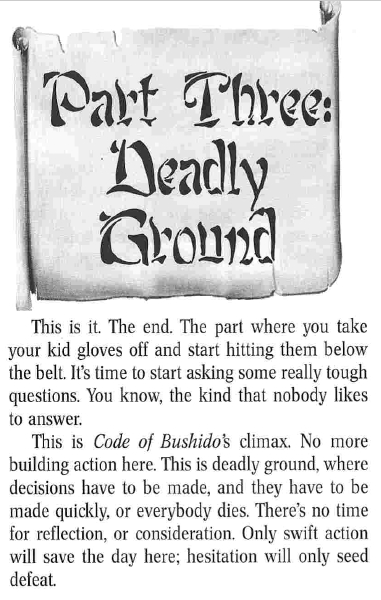
Having read Play Dirty, that throws up some red flags. The adventure is about as bare bones as you can possibly get. Shortly after the conclusion of the murder mystery Yoroshiku is kidnapped. A note is left behind, ostensibly by Niban, saying that he will marry her and claim his place among honorable samurai. The book suggests that your players should notice that this goes against what they know of Niban. Maybe? The odds are pretty good that your players have had no contact with Niban since the first adventure and only know him as the ronin who negotiated with them for the scrolls. Expecting them to know more about his character is a long shot.
For no clear reason the Phoenix who are hosting Winter Court are reluctant to get involved in resolving the kidnapping, so the issue falls into the lap of Shinjo Gidayu. He was the daimyo from the first adventure who got the PCs to guard the scrolls and also left Shinjo Iruko as the PCs’ bodyguard. It’s assumed that Iruko has made herself friendly toward the PCs and has shown romantic feelings toward one of them. Gidayu uses this as leverage in implies that he will let her marry if they resolve the kidnapping reasonably.
Well, the PCs know who kidnapped the princess and where he is since they’ve been to his village before, so off they go. They get there and find Niban in an agitated state. Why? Well, it turns out that he’s been set up. His own lieutenant, a ronin woman named Tobuko, feels that he’s gotten too complacent. For the last two years Niban has been acting as a petty lord over the Village of the Nightingale. Growing crops, dealing with peasants, and collecting taxes. She thinks it’s boring and wants to get back to the exciting parts of ronin life one way or the other. She also knows something about Niban’s backstory.
It turns out Niban was once Shinjo Niban, and was second in command to Shinjo Gidayu. It turns out that Shinjo Gidayu is a shitty person and got into an affair with an Imperial woman named Otomo Jiko and accidentally got her pregnant. She claimed the baby was her husbands and that baby grew up to be Otomo Yoroshiku. Shinjo Niban found out about the baby and the affair and was so horrified that his master has polluted the Imperial line that he threatened to report it. Gidayu ordered him to commit seppuku. Instead Niban ran away and became a bitter ronin. Remember in the first adventure when Gidayu said “I have no karo.”? No? Your PCs probably don’t, either, and that’s assuming they even asked.
Niban’s lieutenant set him up by kidnapping Yoroshiku, hiding her in the village and leaving the note, and then telling him that an armed band was coming from Phoenix lands and letting his natural paranoia take over. He doesn’t know that Yoroshiku is tied up in a hut in his village and if she is found he will just double down on thinking the PCs set him up to kill him.
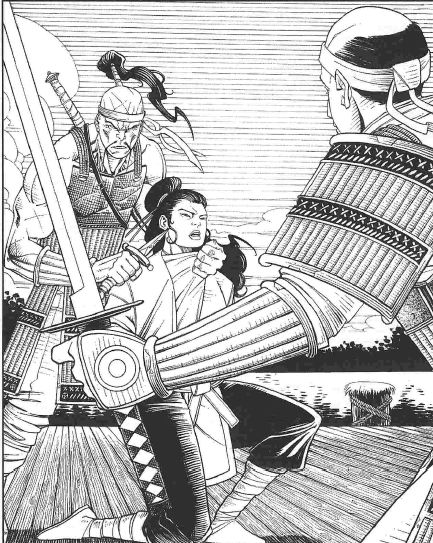
If the PCs do just ride up ready to kill then they’re met with dozens of ronin in hiding and will die quickly. If they come to the village ready to talk, Niban will talk. He’s a tough man to convince, though. It seems that much of this adventure was a set up for this moment – a chance for John Wick to tear into the idea of honor and how foolish it is. The second that Yoroshiku’s name is dropped, Tobuko feigns ignorance and sends some ronin to look for the princess. According to the adventure, you have exactly 15 seconds to debate Niban about why he should give himself up. If they bring up honor, loyalty, or bushido, Niban has some pre-scripted responses showing how stupid and hypocritical the PCs are for following any of it. When 15 seconds has passed, the ronin find Yoroshiku in the hut. It pretty well breaks Niban’s mind and he grabs her, puts a knife to her throat, and lets the PCs attempt to talk him out of it. He also spills the beans on Yoroshiku’s parentage since that's his main goal.
Now we get our thrilling climax:
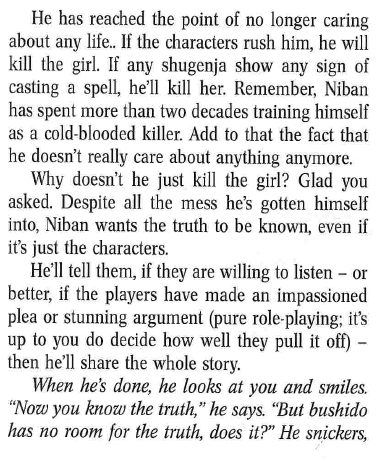
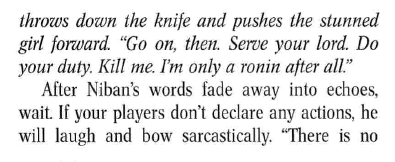
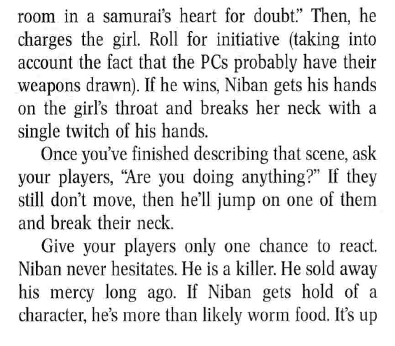
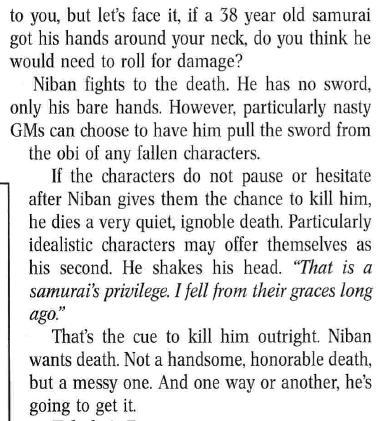
That’s pretty much how it goes. It has a lot of Wickisms built into it. It conflates player action with character action, it minimizes the character’s agency, and totally ignores the system the game is built on in favor of whatever John Wick wants to happen. All of it is there to force your characters into a situation where trying to be honorable is a bad choice and following bushido is a mistake that leads to bad outcomes. If I had to describe Play Dirty era John Wick’s GMing style in a nutshell, it would be that scene. It specifically annoys me because who cares if he’s a 38 year old samurai with experience killing? You have samurai, too, and they probably have their weapons already drawn. The man isn’t magic.
Anyway, if Yoroshiku survives she demands that the PCs kill Tobuko for kidnapping her. They’re still grossly outnumbered and will probably want to find a more diplomatic solution. If they get out alive with Yoroshiku, she demands they shut their mouths about her parentage. It’s probably a good idea that they do, too, since they’ll be implicating a scandal against Yoroshiku and Gidayu, both of whom are likely to be far higher in social status. Unless they are Emerald Magistrates (the Rokugani FBI) they probably don’t have the standing to make such an accusation stick. If they try it, Gidayu demands a duel for his honor and sends Shinjo Iruko to fight in his place. Presumably at this point she is well liked by the party and to win would mean her death. To lose would mean the death of the dueling PC and utter dishonor of all the rest. Wick has effectively tied up the scenario in a way to show how honor and the way of the warrior is a sham abused by the powerful to control their underlings. Basically your PCs probably sit on the knowledge and let the real criminals get away with it. It’s a really strange point to make in a game where honor is a stat and high honor has obvious benefits. I can see this being a decent point if this was the real world, but in the world of Rokugan honor is ridiculously important and Wick’s point goes totally against the spirit of the game.
And that’s the end. If your players tried to do the right thing, at best they now have a mixed reputation. At worst they’re dead or disgraced and have made powerful enemies. Why did you try to do the honorable thing, Lion Clan samurai who has been raised on honor your whole life?
That’s the end of the adventure. There is also a short bit of history and mechanics on the Mantis Clan shoehorned in awkwardly at the end of the book. It was their first real appearance in the RPG. It includes their 3 rank bushi school and is basically reprinted in The Way of the Minor Clans. Not too interesting to talk about, though.
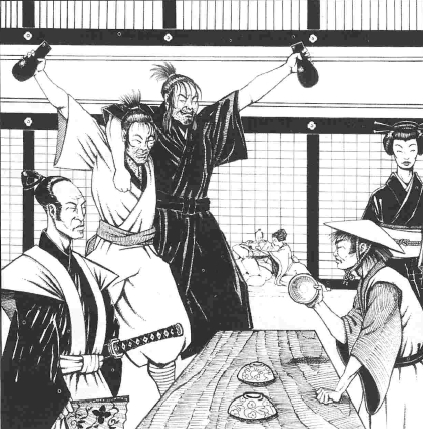
If you ever wondered why people love the Mantis, this is the first ever image of them from the RPG.